Viral Antigens(病毒抗原)
A viral Antigen is an antigen with multiple antigenicities that is protein in nature, strain-specific, and closely associated with the virus particle. A viral antigen is a protein encoded by the viral genome.A viral protein is an antigen specified by the viral genome that can be detected by a specific immunological response.
Viruses are infectious pathogens that cause serious diseases & major threats for global public health, such as influenza, hepatitis, & AIDS. Virus is a sub-micrometer particle that has DNA or RNA packed in a shell called capsid. Viral antigens protrude from the capsid and often fulfill important function in docking to the host cell, fusion, and injection of viral DNA/RNA. Antibody-based immune responses form a first layer of protection of the host from viral infection; however, in many cases a vigorous cellular immune response mediated by T-cells and NK-cells is required for effective viral clearance. When cellular immunity is unable to clear the virus, the infection can become chronic, and serum antibodies to the viral pathogen are used as first indicator for the diagnosis of the disease.
ELISAs provide a valuable tool in the detection and diagnosis of virus infection. The ability to produce recombinant viral proteins will ensure that future ELISAs are safe, specific and rapid. Even when a virus cannot be cultured, provided gene sequence is available, it is possible to rapidly respond to emerging viruses and new viral strains of existing pathogens.
Recombinant viral antigens contain part of viral sequence meaning that the recombinant antigen contains a region which can be recognized by different antibodies produced by different individuals. This reduces the risk of false negatives which can occur with synthetic peptides, which contain only a small portion of the entire protein. If an individual infected with a viral antigen makes antibodies to a part of the protein not included in the synthetic peptides, a false negative results.
Recombinant viral protein usually contains a fusion protein/partner which produces superior attachment to assay surfaces such as wells. For this reason, smaller amounts of recombinant protein will produce the same results as larger amounts of unfused protein. The choice of fusion partner prevents false positives, allowing superior adhesion without incorrect results.
Recombinant Viral proteins are expressed in bacteria, yeast, mammalian cells, and viruses. E. Coli cells were first to be used for this purpose but the expressed proteins were not glycosylated, which was a major drawback since many of the immunogenic proteins of viruses such as the envelope glycoproteins, were glycosylated. Nevertheless, in many instances, it was demonstrated that the non-glycosylated protein backbone was just as immunogenic. The obvious advantage of recombinant viral antigens is that they are available in unlimited quantities and the production and quality control processes is simple.
Advantages of defined using recombinant viral antigens:
1. Production and quality control is simple.
2. No nucleic acids or other viral or external proteins, therefore less toxic.
3. Safer in cases where viruses are oncogenic or establish a persistent infection.
4. Feasible even if virus cannot be cultivated
Disadvantages:
1. May be less immunogenic than conventional inactivated whole-virus vaccines.
2. Requires adjuvant .
3. Fails to elicit CMI.
Facts about Viral Antigens:
1. A Viral Protein Mimics its Way into cells.
2. Viral Protein Helps Infected T Cells Stick To Uninfected Cells.
3. The Viral Protein A238L Inhibits Cyclooxygenase-2 Expression through a Nuclear Factor of Activated T Cell-dependent Trans-activation Pathway.
4. Viral Protein is an effective preventative against ear infection.
5. HIV-1 Viral Protein R Induces Apoptosis via a Direct Effect on the Mitochondrial Permeability Transition Pore.
6. The Level of Viral Antigen Presented by Hepatocytes Influences CD8 T-Cell Function.
7. Antigen-presenting cells from calves persistently infected with bovine viral diarrhea virus, a member of the Flaviviridae, are not compromised in their ability to present viral antigen.
8. There is a difference in the distribution and spread of a viral antigen, development of lesions and correlation between presence of viral antigen and lesions.
9. The absence of viral antigens on the surface of equine herpesvirus-1-infected peripheral blood mononuclear cells is a strategy to avoid complement-mediated lysis.
10. Viral Protein Influences Key Cell-signaling Pathway.
11. A viral protein produced by cancer-causing virus influences a key signaling pathway in the immune cells that the virus infects. This stimulates the cells to divide, helping the virus spread through the body.
12. Protection by recombinant viral proteins against a respiratory virulent avian metapneumovirus has been achieved.
13. Viral O-acetylesterases are found in influenza C viruses and Corona-viruses. Viral O-acetylesterases remove cellular receptors from the surface of target cells which destroys the receptor. Recombinant viral O-acetylesterases derived from Sf9 insect cells as chimeric proteins fused to eGFP specifically hydrolyze 9-O-acetylated sialic acids, while that of sialodacryoadenitis virus, a rat coronavirus related to mouse hepatitis virus, is specific for 4-O-acetylated sialic acid. The recombinant esterases were shown to specifically de-O-acetylate sialic acids on glycoconjugates. The recombinant viral proteins can be used to unambiguously identify O-acetylated acids.
Products for Viral Antigens
- Borrelia(28)
- Chagas(3)
- Chikungunya(7)
- Chlamydia(10)
- Cytomegalo(8)
- Dengue(50)
- Ebola(4)
- EBV(13)
- Encephalitis(8)
- Feline Leukemia Virus(1)
- Hantavirus(1)
- HBsAg(7)
- Helicobacter Pylori(3)
- Hepatitis A(15)
- Hepatitis B(10)
- Hepatitis C(85)
- Hepatitis D(1)
- Hepatitis E(5)
- Herpes(11)
- HERV-K(1)
- HIV(151)
- HTLV(6)
- Influenza(72)
- Lassa(2)
- Malaria(71)
- Mumps(1)
- Mycoplasma(4)
- Norovirus(4)
- Papillomavirus(5)
- Parvovirus(3)
- Rubella(3)
- S. Typhi(5)
- SARS(85)
- Shiga Like Toxin(2)
- Toxoplasma(9)
- Treponema(16)
- Varicella(3)
- West Nile(2)
- Zika(13)
- Cat.No. 产品名称 Information
-
GP26418
CoV-2 N-Mosaic
The E

-
GP26414
CoV-2 Nucleocapsid
The E

-
GP26424
CoV-2 Omicron
The E

-
GP26392
CoV-2 S1 (1-681)
The HEK293 derived recombinant protein contains the Coronavirus 2019-nCoV Spike Glycoprotein S1, Wuhan-Hu-1 strain, amino acids 1-681 fused to Fc tag at C-terminal having a Mw of 76 kDa

-
GP26399
CoV-2 S1 (16-685)
The recombinant Coronavirus 2019 CoV-2 Spike Glycoprotein S1, Wuhan-Hu-1 strain containing a total of 680 amino acids (16-685) and having a calculated Mw of 76

-
GP26401
CoV-2 S1 (16-685), Biotin
TheHEK293 derived Biotinylated recombinant protein contains the Coronavirus 2019 CoV-2 Spike Glycoprotein S1, Wuhan-Hu-1 strain, amino acids 16-685 fused toHis tag & Avi-tag at C-terminal

-
GP26400
CoV-2 S1 (16-685), Fc
TheHEK293 derived recombinant protein contains the Coronavirus 2019 CoV-2 Spike Glycoprotein S1, Wuhan-Hu-1 strain, amino acids 16-685 fused to Fc tag at C-terminal

-
GP26398
CoV-2 S1 (319-529)
The recombinant Coronavirus 2019-nCoV Spike Glycoprotein-S1 Receptor Binding Domain containing a total of 221 amino acids (319-529) and having a calculated Mw of 24

-
GP26397
CoV-2 S1 (319-537)
The HEK293 derived recombinant protein contains the Coronavirus 2019 Spike Glycoprotein S1 Receptor Binding Domain [ RBD ], Wuhan-Hu-1 strain, amino acids 319-537, having a Mw of 26

-
GP26394
CoV-2 S1 (319-541), Sf9
Recombinant Coronavirus 2019-nCoV Spike Glycoprotein-S1 Receptor Binding Domain is a single, glycosylated polypeptide chain containing a total of 232 amino acids (319-541) and having a calculated Mw of 26

-
GP26391
CoV-2 S1, Sf9
The Sf9 derived recombinant protein contains the Coronavirus 2019 CoV-2 Spike Glycoprotein S1, Wuhan-Hu-1 strain, amino acids 1-674 fused toHis tag at C-terminal

-
GP26402
CoV-2 S2
The HEK293 derived recombinant protein contains the Novel Coronavirus 2019-nCoV Spike Glycoprotein S2, Wuhan-Hu-1 strain, amino acids 685-1211 fused to Fc tag at C-terminal

-
GP26403
CoV-2 S2, Sf9
The Sf9 derived recombinant protein contains the Coronavirus 2019 CoV-2 Spike Glycoprotein S2, Wuhan-Hu-1 strain, 685-1211 amino acids, having a Mw of 60

-
GP26406
CoV-2 Spike (1000-1200)
The E

-
GP26408
CoV-2 Spike (300-600)
The E

-
GP26410
CoV-2 Spike (318-542)
Recombinant Coronavirus 2019 Spike Receptor Binding Domain (318-542 aa) having a Mw of 25

-
GP26405
CoV-2 Spike (800-1000)
The E

-
GP26404
CoV-2 Spike E-Mosaic
The E

-
GP26413
CoV-2 Spike S1 (200-800)
The E

-
GP26390
CoV-2-S1
The HEK293 derived recombinant protein contains the Novel Coronavirus 2019-nCoV Spike Glycoprotein S1, Wuhan-Hu-1 strain, amino acids 1-674 fused to Fc tag at C-terminal

-
GP26393
CoV-2-S1 (319-541)
The HEK293 derived recombinant protein contains the Coronavirus 2019 Spike Glycoprotein S1 Receptor Binding Domain [ RBD ], Wuhan-Hu-1 strain, amino acids 319-541 fused toHis tag at C-terminal

-
GP26396
CoV-2-S1 (319-541), Biotin
The HEK293 derived Biotinylated recombinant protein contains the Coronavirus 2019 Spike Glycoprotein S1 Receptor Binding Domain [ RBD ], Wuhan-Hu-1 strain, amino acids 319-541 fused to His tag & AVI tag at C-terminaland having a molecular mass of 28

-
GP26395
CoV-2-S1 (319-541), Fc
The HEK293 derived recombinant protein contains the Coronavirus 2019 Spike Glycoprotein S1 Receptor Binding Domain [ RBD ], Wuhan-Hu-1 strain, amino acids 319-541 fused to Fc tag at C-terminal

-
GP26407
CoV-2-Spike (1-1211)
The CHO derived recombinant protein contains the Coronavirus 2019-Spike Full-Length protein, Wuhan-Hu-1 strain, amino acids 1-1211 having a Mw of 134 kDa fused to His tag at C-terminal

-
GP26409
CoV-2-Spike (1-260)
The HEK293 derived recombinant protein contains the Coronavirus 2019-Spike N-Terminal Domain, Wuhan-Hu-1 strain, amino acids 1-260 fused to Fc tag at C-terminal

-
GP25172
CoV-229E
Coronavirus 229E Recombinant

-
GP25174
CoV-NL63
Coronavirus NL63 Recombinant

-
GC48954
CP21
An iron chelator

-
GC25306
CQ31
CQ31, a small molecule, selectively activates caspase activation and recruitment domain-containing 8 (CARD8).
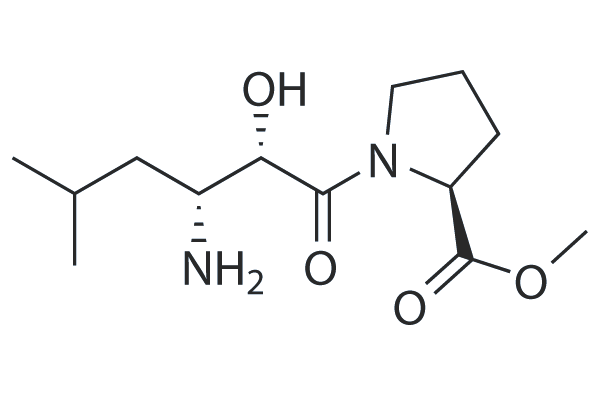
-
GC47139
Cycloaspeptide A
A fungal metabolite

-
GC47142
Cycloguanil-d6 (hydrochloride)
环氯胍盐酸盐 d6 (盐酸盐)
A neuropeptide with diverse biological activities
-
GC64068
Cyclotriazadisulfonamide
1,5,9-三氮杂环十二烷,3-亚甲基-1,5-双[(4-甲基苯基)磺酰基]-9-(苯基甲基)-,CADA
Cyclotriazadisulfonamide (CADA) 是一个特异性的 CD4 靶向的 HIV 进入抑制剂。Cyclotriazadisulfonamide (CADA) 以信号肽依赖的途径抑制 CD4 进入 内质网腔进行共翻译转位。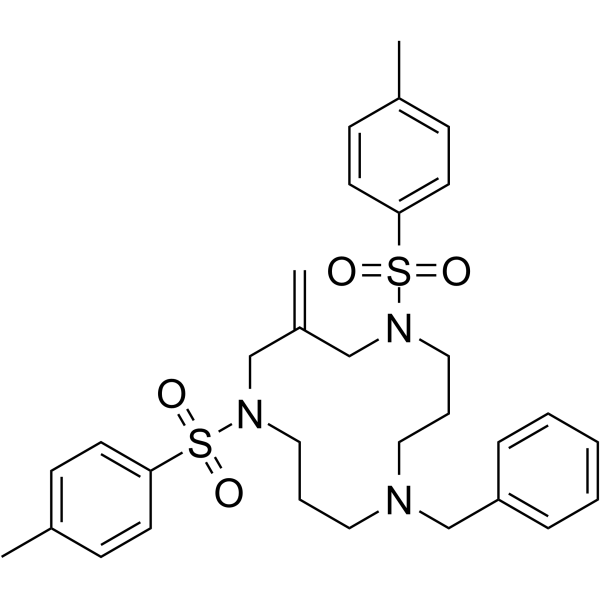
-
GC68930
Cys-TAT(47-57) TFA
Cys-[HIV-Tat (47-57)] TFA
Cys-TAT(47-57) (Cys-[HIV-Tat (47-57)]) 是能穿透细胞的富含精氨酸的十二肽,是 HIV-1 反式激活蛋白衍生物。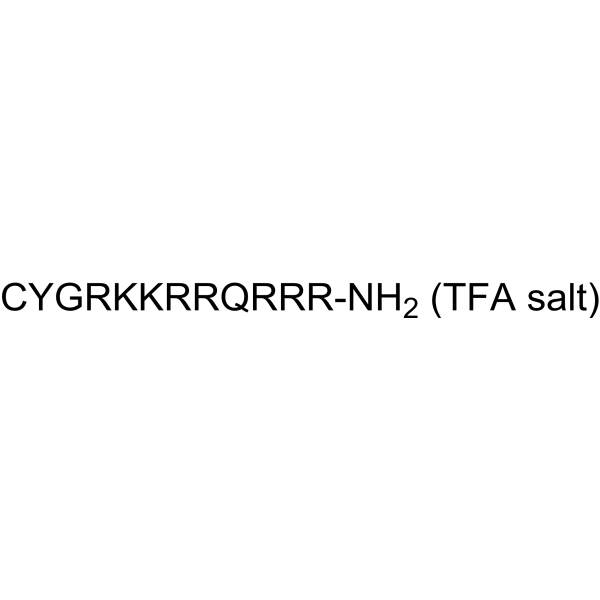
-
GC64391
DDX3-IN-2
DDX3-IN-2 是一种活性 DEADbox polypeptide 3 (DDX3) 抑制剂,其 IC50 值 0.3 μM。DDX3-IN-2 表现出广谱的抗病毒活性。DDX3-IN-2 有克服 HIV 耐药的潜力。
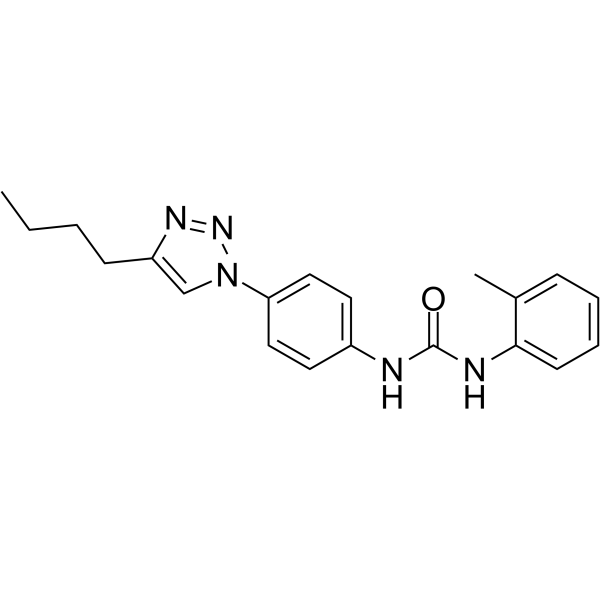
-
GC52191
Deacetylanisomycin
脱乙酰茴香霉素
A derivative of anisomycin
-
GC64270
Decanoyl-RVKR-CMK TFA
DecRVKRcmk TFA
Decanoyl-RVKR-CMK (DecRVKRcmk) TFA 抑制过表达的 gp160 加工和 HIV-1 的复制。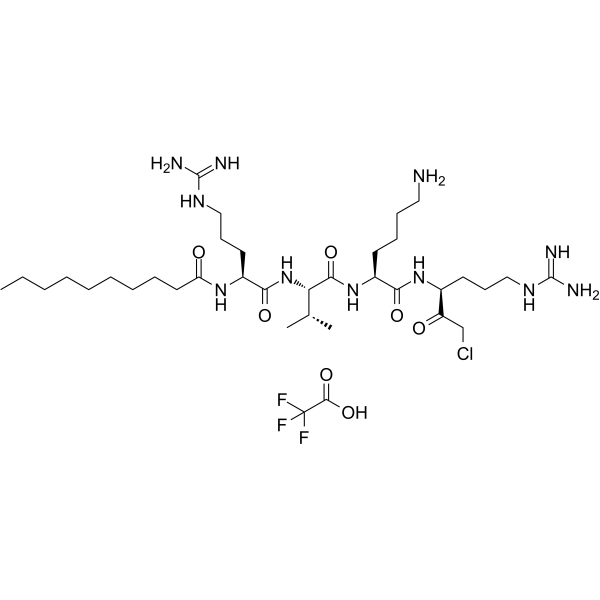
-
GP25537
Dengue Envelope-1 & 3
Dengue Virus Subtype 1 & 3 fused Envelope 58kDa Recombinant

-
GP25538
Dengue Envelope-1 & 4
Dengue Virus Subtype 1 & 4 fused Envelope 55kDa Recombinant

-
GP25540
Dengue Envelope-1 15kDa
Dengue Virus Subtype 1 Envelope 15kDa, C-Terminal (Domain III) Recombinant

-
GP25523
Dengue Envelope-1 22kDa
Dengue Virus Subtype-1 Envelope 22kDa Recombinant

-
GP25529
Dengue Envelope-1 32kDa
Dengue Virus Subtype 1 Envelope 32kDa Recombinant

-
GP25533
Dengue Envelope-1 45kDa
Dengue Virus Subtype 1 Envelope 45kDa Recombinant

-
GP25541
Dengue Envelope-1, Insect
Dengue Virus Subtype 1 Recombinant, Insect Cells

-
GP25539
Dengue Envelope-2 & 4
Dengue Virus Subtype 2 & 4 fused Envelope 52kDa Recombinant

-
GP26445
Dengue Envelope-2 14 kDa
Recombinant Dengue Envelope 2 produced in E

-
GP25524
Dengue Envelope-2 22kDa
Dengue Virus Subtype-2 Envelope 22kDa Recombinant

-
GP25530
Dengue Envelope-2 32kDa
Dengue Virus Subtype 2 Envelope 32kDa Recombinant

-
GP25534
Dengue Envelope-2 45kDa
Dengue Virus Subtype 2 Envelope 45kDa Recombinant

-
GP25542
Dengue Envelope-2, Insect
Dengue Virus Subtype 2 Recombinant, Insect Cells

-
GP25525
Dengue Envelope-3 22kDa
Dengue Virus Subtype-3 Envelope 22kDa Recombinant





